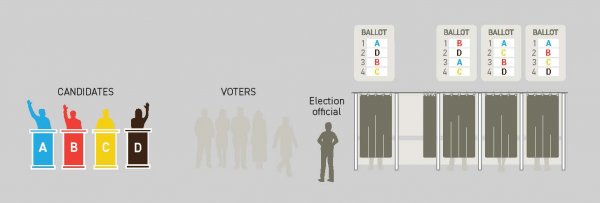Ranked-choice voting allows citizens to rank their candidate preferences on an election ballot instead of voting for a single candidate. If one candidate does not initially win a majority, competitors with the fewest votes are eliminated from the race and their voters’ second choices are applied to the tallies of the remaining candidates until one candidate achieves a majority.
According to the group FairVote, two states have 2020 ballot initiatives to install a statewide ranked-choice system. Alaska’s Ballot Measure 2 would replace partisan primaries with an open primary in which the top four finishers advance to a ranked-choice general election, while Massachusetts’ Question 2 would retain partisan primaries but implement ranked-choice voting in both primaries and the general election starting in 2022.
Maine’s state Supreme Court voted on Sept. 8 to allow ranked-choice voting to appear on 2020 presidential election ballots but has not decided whether a ballot initiative challenging the use of ranked-choice voting will actually keep voters from selecting candidates that way.
Which states have ranked-choice voting?

How Ranked-Choice Voting Works
1. Voters rank their candidate preferences on ballots
Voters can choose to rank candidates, indicating on a ballot which person is their first choice, second choice, third choice, etc., for election to office.

2. First-choice candidate votes on ballots are tallied
If one of the candidates receives more than 50 percent of the first-preference votes, that candidate wins the election.

3. Second-choice votes of losing candidates are distributed among winning candidates
If no candidate receives more than 50 percent of the votes, the candidates with the lowest percentages of votes are eliminated and their supporters’ second-choice selections are allocated to the remaining candidates on the ballot. This vote-redistribution process continues until one candidate reaches over 50 percent of the cast votes.

Pros and Cons of Ranked-Choice Voting
PROS
Could ensure that a winning candidate has a majority of votes
In elections in which there are several candidates, ranked-choice voting allows voters to support like-minded competitors to defeat an unfavored candidate. Fractured opposition can result in an unfavored candidate winning an election even if most voters oppose them.
Voters’ ballots count, even if their first choice loses
Even if your first-choice candidate loses, your vote still counts toward electing a candidate of your choice.
CONS
Voters’ choices may not count if all of them are eliminated
If a voter does not rank all of the candidates’ names on a ballot, leaving some selections blank, and if all of the voter’s choices are eliminated, that could result in the ballot not being counted at all.
This post is excerpted from a DataPoint infographic that was initially made available to POLITICO Pro Premium subscribers on September 10, 2020.
If you would like to learn more about POLITICO Pro Premium, you can visit this page.

